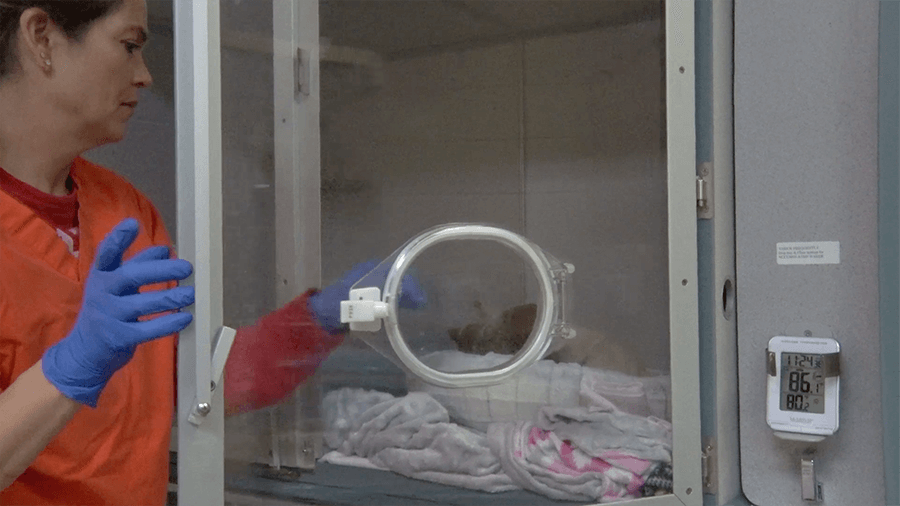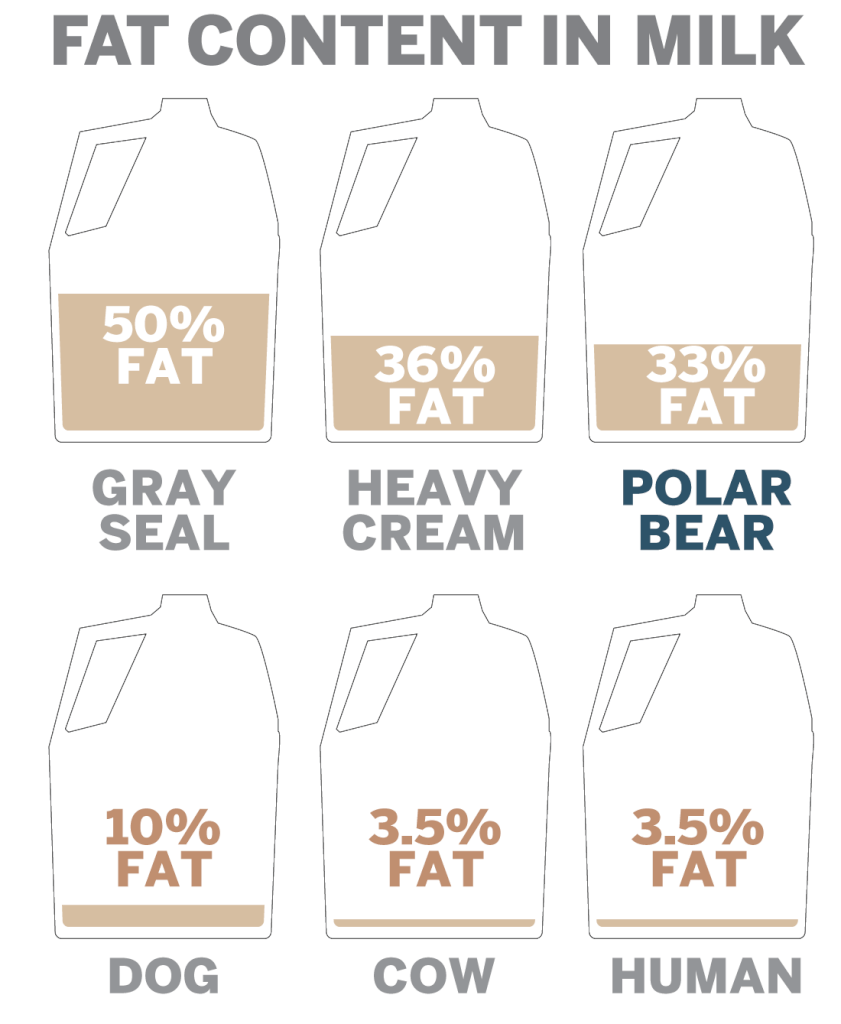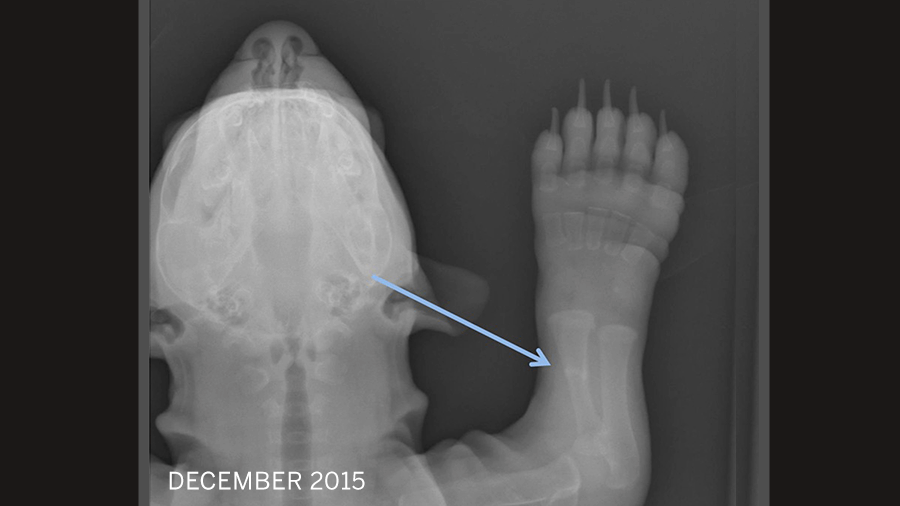America's lonely bear cub: the story of a miracle

Photo: Columbus Zoo
In the Columbus Zoo in Ohio, a polar bear was born, named Nora, but on the sixth day of her life, her mother Aurora left a baby who was no more squirrel, blind and deaf at that time.
Therefore, the zoo staff had to nurse a charming little bear, and this task turned out to be very difficult, the newspaper writes Oregonlive.
Nora was the first newborn polar bear to live more than a few days at the Columbus Zoo since it opened in 1927. Her birth outside the wild was a miracle and the baby was priceless. When Aurora first left the den, zoo veterinarian Priya Bapodra was alarmed - in the wild, polar bears never leave their cubs for a minute, but the specialist still hoped for the animal's maternal instinct.
Nora was the only surviving cub born in the United States in 2015. Her brother lived less than two days and died with an empty stomach - zoo staff believe that he had never tasted his mother's milk.
Polar bears represent independence and strength, but their newborn babies are very fragile.
Bears mature late, have small offspring and spend a lot of time and energy growing their young.
According to the most optimistic estimates, there are about 26 thousands of polar bears in the world, therefore, each individual is very valuable.
To survive, polar bears need ice, and it is now melting quickly. NASA researchers have concluded that summer ice in the Arctic is shrinking by an average of 13% over the decade starting in the 1980-s.
Nora's wild relatives use ice to hunt. When the ice melts earlier, the bears are forced to swim further to find food, and accordingly they have to starve for a long time on land, which disrupts their ability to breed. According to some predictions, two-thirds of polar bears may disappear by 2050. One of the few places in the world where bears breed, are zoos.
Therefore, Nora’s troubles with her mother were taken by the owners of the Columbus Zoo very seriously.
Mother did not pay any attention to her crying, but at the same time these pitiful sounds greatly cared for the staff of the zoo.
After an hour of absence of the mother in the den, the owner of the zoo, Devon Sabo, attempted to lure the bear back to the straw cub, but Aurora did not react, so the zoo staff came to the conclusion that her mother abandoned Nora.
Most polar bears born in captivity live less than a month. Only about a third of them live to adulthood. In newborn cubs, which are nursed by people, the chances of survival are even lower.
These babies are vulnerable to disease and infection. They suffer from malnutrition and bone problems because the polar bear’s mother’s milk cannot be artificially produced.
Four hours after Aurora left the lair, Nora's cry began to weaken, so it was decided to take the baby out of the lair. While the zoo staff distracted the mother with fish, the vet Priya Bapodra took Nora out of the den.
Little Bear didn’t like the idea very much. Nora tried to fight off the touch of a creature with an unfamiliar smell. The animal weighed only one and a half pounds (about 700 g) and was very cold, which made Priya worry about the baby's fate.
When the vet measured the temperature of the bear, the thermometer showed no numbers, the word “low” (“low").
This was what the doctor feared the most. Nora, who spent more than four hours without the heat of her mother, was so cold that the thermometer simply could not determine the temperature of her body. In addition, the baby was disoriented and angry. Priya Bapodra knew that if she did not warm and stabilize the state of the bear, the cub would soon die.
Priya chose one of the smallest needles that were available at the veterinary center of the zoo, and took blood for analysis from the bear's thigh.
At the same time there was a rather high probability that the efforts of the veterinarian and the zoo staff would not save the life of Nora anyway. Several zoos tried to raise polar bears without a mother, and most of them failed.
Of the roughly 70 polar bears born in zoos and game reserves in North America, only four newborns were successfully raised without the help of their mothers.
Columbus Zoo was faced with the task of not only saving Nora's life, but also of preserving her natural wildness. And although the bear would have to communicate mainly with people, it was necessary to somehow teach her to be a bear.
Even before the birth of a teddy bear at the zoo, an 23-page plan was prepared with step-by-step instructions for feeding the baby in different situations; there was also a section on how to act if the mother refused the newborn.
The zoo also had an incubator the size of two refrigerators, which was supposed to maintain Nora’s body temperature. Priya put on it a mode in 88 degrees Fahrenheit (31 degrees Celsius) and laid out the incubator with clean baby blankets.

Photo: Columbus Zoo
Dana Hatcher, who led the nutrition center at the zoo, also joined the Nora moms group. She had to make up the formula for feeding the baby, and she had to act very quickly.
The task was very difficult, since polar bear milk is a special product in its composition. Dana could quickly prepare food for lemurs or flamingos, but a polar bear cub is on the list of animals that are very difficult to feed artificially.
In the wild, adult bears eat seals, very fat animals, which make the composition of polar bear's milk rich and unique. When creating an artificial formula in the conditions of the zoo, it was impossible to find a complete replacement for the seal meat, and the wrong diet could lead to problems with the bones of the bear cub.
To create the formula, Dana used the research of a veterinarian from the San Francisco Zoo, who was able to study the milk of polar bears in the wild just a few years before the birth of Nora. Scientists literally milked the euthanized wild polar bears in order to explore the formula of their milk. Thanks to the data from this study, Dana knew what nutrients and in what proportions Nora needed.
The nutritional basis for Nora was milk formula for kittens (polar bears do not tolerate cow or goat milk), but there was too much lactose in it, through experiments she found out that lactose levels can be reduced when heated.
Dana also knew that polar bears need a lot of taurine, which helps in the absorption of vitamins, so she added chopped taurine tablets to the mix. The most difficult task was to give the milk mixture a sufficient level of fat, the source of which was not easy to find.

Infographics: OREGONIAN RESEARCH
Human and cow's milk contain about 3,5% fat. Polar bears' milk is 10 times fatter. The closest product in the supermarket in terms of fat content to this product is whipped cream.
Artificial feeding plan for the cub recommended adding herring oil to the mixture, but it was available only in Canada, and Dana did not have it. She considered the options available to her and decided to use safflower oil. It had a mild flavor and was easy to work with.
After mixing the mixture, it turned out too thick, and the teddy bear could not drink it.
Dana understood that she needed a smaller mixer, and they immediately sent him to the zoo employee for the supermarket. With a new car, after several attempts, Dana managed to create the right mix.
The first feeding Norah was assigned to Cindy Capps, who had worked at the zoo for a long time and had experience feeding many babies.
The woman put the bear cub on her knees, holding her head upright, and slipped the bottle with the dummy to her mouth. The baby, who had not eaten for almost 5 hours, began to suck the mixture very actively.
Of all the “moms”, Nora Priya was worried the most. Nora spent only six days with her mother before she had to take her from the den. Did she get enough antibodies from her mom to prevent pneumonia? Is it too cold, is it too warm? Every day there were more and more new questions.
Nora left her cozy incubator only for feedings and medical examinations. If Priya needed to go out, she would ask one of the other “mothers” to be with the cub and look after him. But everyone was worried - the bear cub was often hugged so that he would remember the smell and feel the warmth of the body.
After just a week of formula feeding, Nora's pink paw pads turned black, and her nose also turned black. Soon the thin, translucent hair on her ears and legs thickened, and she became whiter and softer. She steadily gained weight - a little more than 30 grams every day.
Gradually, the “mothers” lowered the temperature in the incubator so that the little one learned to independently regulate the temperature of her body, they tried not to talk much and not to make noise, keeping the muffled light in the incubator, like in a den, giving the bear a chance to sleep and grow.
Each of the moms had a job at the zoo, besides caring for Nora. Shifts of some of them sometimes lasted up to 28 hours. Priya ate Thanksgiving dinner on the floor of the intensive care unit, next to the Nora incubator.
After about three weeks, the bear became more energetic. His eyes were still closed, but he began to move independently around the incubator. His head was still too big, and his stomach was too round to stand.
“Moms” gave Nora more freedom, allowing her to walk on rubber mats on the floor so that she could learn to walk.
After 30 days of feeding, Nora's ghostly chances of survival once improved to the likelihood of 50 on 50.
Soon after this, the cub opened his eyes for the first time, but did not see snow and ice, he saw people - his nurses.
While the “mothers” were busy growing Nora, Dana was looking for options to get herring oil at the food center. Fish oil had a better fatty acid composition than the safflower oil they used. As soon as she found a supplier in Canada, Dana began to gradually add new fat to the Nora formula.
At the end of December, Priya noticed oil in a bear's stool. After Dana started adding herring oil to her diet, Nora’s growth slowed.
Priya began to worry, but there was so little data on the artificially fed cubs of polar bears that the vet was not sure how to solve this problem. Nora was 54 of the day, and Priya decided to conduct a full inspection of the bear, and the results were not the best.
Vitamin D and calcium levels were low, namely, they are necessary for the full development and growth of bones.
Priya also x-rayed a bear's bones, and her results were very upset. One of the bones was broken, some bones that should be straight were twisted. Nora suffered from metabolic bone disease.

Photo: Columbus Zoo
Despite everything Dana did, Nora didn’t receive all the nutrients she needed.
After testing and research, the veterinarian found out that safflower oil was more suitable for Nora, and problems with bones began after switching to herring oil. Studies have shown that herring oil is better for polar bear cubs, but the case of Nora was an exception.
Therefore, it was decided to return safflower oil to its food, as well as add additional calcium to the formula, the bear cub was also given injections of vitamin D.
Nora showed no signs that she was hurt, but polar bears do not always show this, so Priya also gave the bear cub light painkillers.
She was also tried to be treated very carefully so as not to damage the fragile bones.
In just a few weeks, the little bear had recovered. The fracture healed, the bones looked much more powerful in the pictures.
Nora gradually grew, and the “mothers” soon needed protection from her claws and teeth, she also lowered the temperature in the incubator so that she could regulate the temperature of her body.
The cub was healthy, but still clumsy - he walked poorly and swayed more.
On 78, Nora learned to walk, and tried to swim on 88.
Soon she was transferred to an open-air cage, where the zoo staff had to show a bear by example that it was safe to swim in the pool.
When Nora wandered around the yard, Shannon was standing at the door where the cub could see her. For a while, Nora looked at Shannon every time a new noise or a strange smell flashed through the fence.
Over time, Nora became the star of the zoo. Reaching the weight of 70 pounds (32 kg), she already spoke to the guests of the zoo, frolicked and fished in the pool.
Look at her debut gathered guests from almost all US states. Thousands of people came to the zoo just to see it.
Nora, who did not seem to know that she was a bear, liked the attention of people. She spent most of her time in front of the glass that separated her from her fans.
Soon, Nora was transferred to another zoo - in Oregon, so that she would have the opportunity to communicate with other polar bears, since it was impossible to combine them with Aurora.
Read also on ForumDaily:
Thousands of scientists warn mankind about global environmental catastrophe
Scientists: Earth has entered an era of mass extinction species
Subscribe to ForumDaily on Google NewsDo you want more important and interesting news about life in the USA and immigration to America? — support us donate! Also subscribe to our page Facebook. Select the “Priority in display” option and read us first. Also, don't forget to subscribe to our РєР ° РЅР ° Р »РІ Telegram and Instagram- there is a lot of interesting things there. And join thousands of readers ForumDaily New York — there you will find a lot of interesting and positive information about life in the metropolis.











